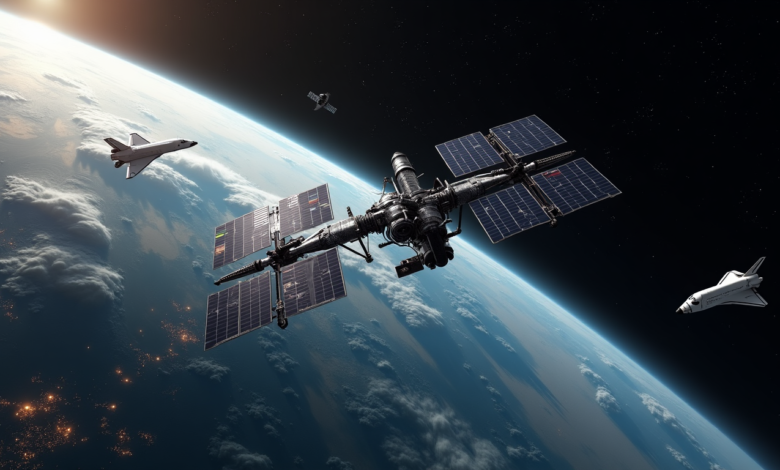
The Geopolitics of Space Exploration: National Policies and Private Sector Influence
A new era of space exploration has emerged with unprecedented rivalry between nations and private companies. Commercial spaceflight organizations now challenge government space agencies worldwide. This competition has created an intricate web of mutually beneficial alliances and rivalries that define today’s space activities. The traditional boundaries between space exploration and national interests have shifted dramatically.
Today’s space sector combines national policies, state-of-the-art technologies, and global partnerships. Different organizations pursue their own goals – from building lunar bases and planning Mars missions to developing space tourism and extracting resources. These ambitious projects bring important questions about space governance, security concerns, and humanity’s future beyond Earth to the forefront.
The New Space Race: Key Players and Objectives
The space race has evolved beyond Cold War competition into a multi-nation pursuit of space exploration goals. The United States, China, and Russia have become the core competitors. Each country has developed advanced space programs with unique strategic goals.
NASA’s Artemis program leads the United States’ efforts to develop the “Lunar Gateway.” This space station will orbit the moon and work as a communication hub and scientific laboratory. China shows its technological capabilities through successful missions like Chang’e-6 and the Tiangong space station. Russia now works with China and has announced joint plans to build an International Lunar Research Station (ILRS).
| Major Power | Key Programs | Main Goals |
|---|---|---|
| United States | Artemis Program | Lunar Gateway, Mars missions |
| China | Chang’e Series | Lunar exploration, ILRS |
| Russia | ILRS Partnership | Lunar base development |
New space powers are making progress faster than ever. India has reached economical space mission milestones that include successful Mars exploration. The United Arab Emirates has revolutionized into a regional space leader that established the Arab Space Cooperation Group and completed the Hope Mars mission.
These space programs want to achieve more than scientific exploration:
- Resource extraction of rare earth metals and helium-3
- Development of permanent lunar settlements
- Establishment of Mars colonies
- Creation of space-based infrastructure
The competition for space resources has become intense, especially when you have nations focusing on the Moon’s potential deposits of titanium, rare earth metals, and helium-3. China’s lunar exploration program targets these resources specifically, while NASA’s initiatives want to extract water from lunar poles to produce rocket fuel.
National Space Policies and Geopolitical Implications
Countries worldwide now develop sophisticated national space policies that demonstrate their understanding of space capabilities as significant markers of global influence and technological advancement. The modern space agenda combines scientific discoveries, economic opportunities, and security concerns that define international relationships in the 21st century.
Space as an extension of national interests
National power now depends heavily on space capabilities that shape economic development and diplomatic relations. Many nations have created complete space policies to safeguard their interests and stimulate economic growth alongside technological progress. Their main goals include:
- Building eco-friendly space sectors
- Deepening their commitment to local expertise
- Advancing scientific and technological capabilities
- Supporting economic diversification
Military and strategic considerations
Space has become a vital domain for military operations and national security. The rapid development of space technology creates new opportunities but also brings unprecedented vulnerabilities. Many nations now invest heavily in space-based capabilities that include:
- Intelligence gathering and reconnaissance
- Military communications and navigation
- Early warning systems
- Position location and timing services
International cooperation vs. competition
Space exploration brings countries together despite ongoing political tensions. The International Space Station stands as a prime example of countries working together and shows how space exploration can exceed political differences.
| Cooperation Area | Benefits | Participating Nations |
|---|---|---|
| Scientific Research | Shared costs, expertise | Multiple countries |
| Space Station | Resource pooling | US, Russia, EU, Japan, Canada |
| Mars Missions | Technical collaboration | International partners |
The rise of commercial space activities and competition for resources creates new challenges in space governance. Countries need updated international space laws now more than ever as private companies and nations join the space sector. These laws must help nations deal with space debris management and resource extraction rights while making space accessible to everyone.
The Rise of Private Space Companies
Private companies have changed space exploration through technological innovation and affordable approaches. Commercial space companies now form a new ecosystem that has changed the traditional government-dominated space sector into a marketplace of private enterprise and public-private partnerships.
SpaceX, Blue Origin, and Virgin Galactic
SpaceX is a 21-year old groundbreaking force in commercial spaceflight. The company achieved multiple firsts that include successful spacecraft recovery and International Space Station missions. Their Starlink project has grown into the largest satellite constellation that ever spread across space. Blue Origin, founded by Jeff Bezos, aims to preserve Earth’s future through space resource utilization and makes space travel available to private citizens. Virgin Galactic creates unique suborbital space experiences and targets the space tourism market with custom flight training programs.
Lowering costs and increasing access to space
Private companies have revolutionized the space industry with dramatically reduced launch costs through state-of-the-art technology and reusable rocket systems. The cost analysis shows these most important improvements:
| Launch Provider | Cost per Launch | Cost per Kilogram |
|---|---|---|
| SpaceX Falcon 9 | $227.67M | $9,988 |
| Traditional Shuttle | $5.88B | $110,163 |
| Soyuz Rocket | $194.62M-826.23M | $29,377 |
These cost reductions stem from several groundbreaking advances:
- Reusable rocket technology that transforms launch economics
- Manufacturing processes built on standardization
- Materials and engineering breakthroughs
- Market dynamics driving competitive launch services
Partnerships with government space agencies
Private companies and government space agencies have built a resilient framework that drives space exploration forward. NASA’s Commercial Crew Program stands as a perfect example of this strategic collaboration that leverages private sector’s capabilities for space station missions. These partnerships enable ambitious projects and reduce government’s financial burden through cost-sharing arrangements and innovative procurement methods.
“NewSpace” companies draw most important private investment that complements public funding. This investment supports both immediate industrial goals and future space exploration plans. The space exploration landscape now offers new possibilities for scientific research, commercial applications, and technological breakthroughs.
Challenges and Opportunities in Space Governance
The rapid rise of space activities has revealed major gaps in international space governance frameworks. The current legal structure that we based on the 1967 Outer Space Treaty doesn’t deal very well with today’s challenges in space exploration and commercialization.
Need for updated international space laws
Space exploration has evolved from a public attempt into a commercial industry that creates unprecedented legal challenges. The existing regulatory framework does not have detailed mechanisms to monitor private space activities. The work to be done requires immediate attention in these areas:
- Property rights in space
- Resource extraction regulations
- International liability standards
- Environmental protection measures
- Cultural heritage preservation
Regulating commercial activities in space
Space commercial activities need a balanced approach between state-of-the-art solutions and oversight. A regulatory gap exists like in a permissionless scheme because clear regulations are missing. This threatens national security and holds back private sector growth. Many countries now create their own space laws. The United Kingdom leads with licensing requirements that reward green practices.
| Regulatory Focus | Current Status | Required Action |
|---|---|---|
| Launch Activities | Partially Regulated | Improved Oversight |
| Resource Extraction | Limited Framework | New Guidelines |
| Debris Mitigation | Basic Guidelines | Strict Standards |
| Environmental Impact | Minimal Rules | Detailed Policy |
Addressing space debris and environmental concerns
Space debris poses a major challenge to space governance today. Space launches have grown tenfold in the last decade, but organizations don’t deal very well with debris mitigation guidelines. The European Space Agency has adopted a “Zero Debris approach” to substantially limit debris production in Earth and lunar orbits by 2030.
New initiatives aim to cut down the maximum time in protected low-Earth orbits from 25 to 5 years. Space agencies across the globe now enforce stricter requirements for future missions that emphasize:
- Better collision avoidance strategies
- Advanced satellite health monitoring
- Effective passivation techniques
- Standard risk assessment tools
The Inter-Agency Space Debris Coordination Committee created detailed guidelines for space debris mitigation. These guidelines now serve as a foundation for UN Space Debris Mitigation Guidelines. This work marks vital progress to ensure environmentally responsible space exploration while protecting orbital environment for future generations.
Space exploration has reached a crucial point. National goals, private sector innovation, and worldwide teamwork now shape humanity’s journey beyond Earth. Space agencies across the globe adapt their plans as commercial players challenge technological limits. This creates a vibrant ecosystem where progress comes from healthy competition and teamwork. The shift needs careful planning about resources, security concerns, and environmentally responsible practices in space.
Today’s space activities need resilient international guidelines to tackle new challenges and encourage innovation and cooperation. Countries and businesses must join forces to create detailed rules for space traffic control, resource use, and environmental protection. The success of space ventures relies on finding the sweet spot between national priorities and worldwide benefits. This balance ensures that our expansion into space helps everyone while respecting each country’s goals.




